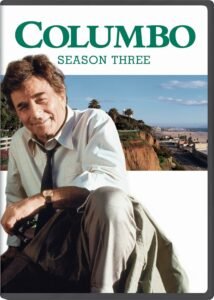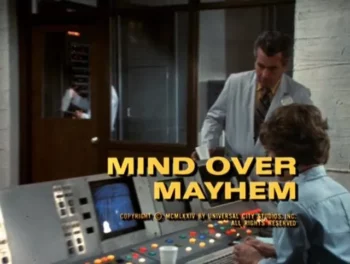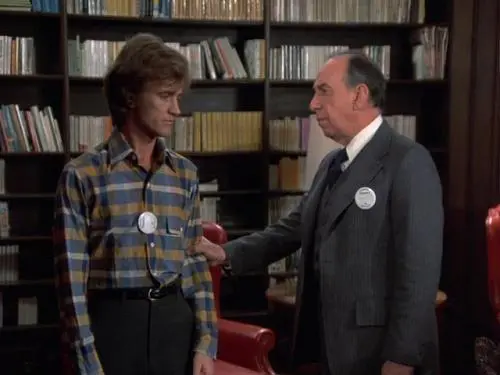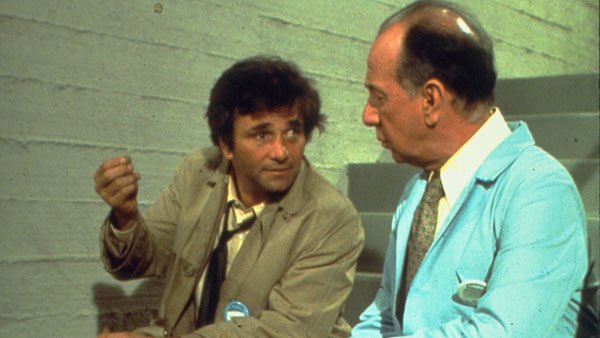Plagiarism in Pop Culture: Columbo (Part 2)

Earlier this week, we took a look at the fifth episode of the third season of the 1970s murder mystery film series Columbo. That episode, entitled Publish or Perish, featured a fake plagiarism plot that was critical to how Columbo solved the crime.
However, from a Plagiarism in Pop Culture perspective, that episode was unusual. The plagiarism plot was introduced at the very end of the episode and was a fabrication by the murderer to try and throw suspicion away from him.
Columbo saw through the lies, and the fake plagiarism plot became pivotal in Columbo proving his case.
But the writers behind Columbo were not done with the topic. They actually did two separate plagiarism plots in back-to-back episodes. The very next episode, episode 6 of season 3, entitled Mind Over Mayhem, involved another plagiarism plot.
However, this one is different in almost every way. In this episode, the plagiarism isn’t instrumental to solving the case, but is the motivation for the crime itself and remains a major theme throughout the episode.
As such, it’s worth revisiting the detective in the wrinkled raincoat as we look at his second battle involving plagiarism.
Content Warning: Spoilers for Columbo Season 3, Episode 6. Also, general discussion of murder/violence.
The Plot

The episode begins with two characters, Dr. Howard Nicholson and Dr. Marshall Cahill, having a tense conversation in Dr. Cahill’s office. The two scientists work at a think tank and performs research in a wide range of areas, including computers.
The topic of the conversation is Dr. Cahill’s son, Neil Cahill, who is due to receive a prestigious award for a scientific discovery he’s been credited with.
However, Dr. Nicholson doesn’t believe that Neil deserves that award. Dr. Nicholson claims that Neil plagiarized the idea from another scientist, using his access at the institute to prove the concepts from the earlier work, but not inventing it.
At the end of the conversation, Dr. Nicholson lays down an ultimatum, either Neil confess to his plagiarism or Dr. Nicholson will publicly expose him at the award ceremony.

Dr. Cahill then hatched a scheme to get Dr. Nicholson out of the way. First, he programmed a robot, one that was built by a boy genius named Steven Spielberg, to perform his tasks in the institute’s computer room.
With his alibi established, he then swiped the keys of another scientist’s car from the institute’s motor pool, drove over to Dr. Nicholson’s house and ran him over in his driveway. He then carried the body inside the house and attempted to stage a robbery.
The robbery narrative, however, fell apart quickly. Columbo immediately noted a shoe mark on the wall and learned that Dr. Nicholson’s injuries were more consistent with a hit-and-run than a beating. It’s clear that Columbo suspects Dr. Cahill, but lacks physical evidence and can’t definitively debunk his alibi.
As the investigation is ongoing, we learn that Neil had been seeing a therapist, namely Dr. Nicholson’s wife, Margaret Nicholson. Neil told her about the plagiarism in a therapy session, and she’s been encouraging him to come clean, saying it would help his mental health.
Neil brings up the idea to his father, who orders him to keep quiet. The two fight over it, but Dr. Cahill cuts it short as he has to catch a flight. While in the air, Neil publicly confesses to the plagiarism, causing Dr. Cahill to get mobbed by reporters upon landing.
Dr. Cahill rushes back to the institute to speak with his son, but both are confronted by Columbo who has officers in tow to arrest Neil, not his father. Columbo presents evidence that Neil and Margaret were having an affair and says that the plagiarism issue must have been the final straw.
The officers arrest Neil, but this prompts Dr. Cahill to confess to the murder. Columbo reveals that he knew it was Dr. Cahill because the killer smoked cigars (which he gleaned from a burnt match), something that only Dr. Cahill did among those with a motive for killing Dr. Nicholson.

Columbo apologizes for the ruse, and the two men smoke cigars in the stairwell while they wait for Dr. Cahill’s eventual arrest.
Understanding the Plagiarism
In many ways, this plagiarism story is the opposite of the one from the previous episode. Here, the plagiarism did take place in-universe, it was the motive for the murder and a major plot point throughout the episode. However, it was not particularly relevant to solving the case.
Still, this raises the question: How realistic is this plagiarism?
The answer is very.
The plagiarism plot involves a young scientist who is accused of plagiarizing a concept from an older, established scientist who otherwise less privileged. He is accused of taking the idea and the discovery, and then using his access to the institute’s computer equipment to prove the concept before the actual creator could.
These types of disputes happen regularly. Researchers accuse one another of stealing ideas, cutting out others of authorship, or just argue about who came up with a concept first.
Similar plagiarism stories happened regularly, both before this episode aired and continued after.
Even today, there are situations where a scientist may come up with a theory but lack the equipment to prove it. Whether they need access to a supercomputer, a particle accelerator or some other specialized equipment, it’s not uncommon for one researcher to come up with a theory and have it proved by others, creating a potential crisis in attribution.
What has changed since 1974 is, first and foremost, digital publication. It’s easier than ever to find papers on obscure topics. Meaning that, if the work Neil plagiarized was previously published, it would have been easier to find for anyone looking into the subject matter.
However, even if that paper hadn’t been peer-reviewed or published, the use of pre-publication libraries like arXiv is common. This means, once again, that the earlier work would be easy to locate, making it less likely that Neil would have gotten as far as he did.
Still, the plagiarism itself is fairly realistic today and was even more so back when the episode aired.
Perhaps the only part of the story that truly beggars belief is the fact that Neil felt guilty about the plagiarism and ultimately confessed before receiving any significant award or accolade.
To be clear, plagiarist confessions do happen out of the blue. We saw this with Jumi Bello just last year. However, they are significantly more common after they’ve been caught or otherwise are beginning to face repercussions. When Neil confessed, the only (living) people who knew were his therapist and his father, neither of which were talking.
It’s very rare for a plagiarist to do the misdeed and then feel so much guilt for the act that they confess without some kind of inciting incident. While this may speak well for Neil’s character, it’s not something you’ll see a lot of in the real world.
Other than that, it’s a realistic tale of plagiarism that is treated with an appropriate level of seriousness that doesn’t cross the line into becoming preachy. It’s a good example of how to use plagiarism in a fictionalized setting while both telling a good story and treating the subject well.
(Note: It also strikes me as unlikely that, even in the 1970s, the mainstream media would care enough about plagiarism in an obscure scientific field to swarm Dr. Cahill upon landing. However, that was necessary to get Dr. Cahill to go back to Los Angeles and doesn’t really impact the plagiarism itself.)
Bottom Line
Even though Columbo had two back-to-back episodes that featured plagiarism as a plot element, it’s safe to say that they were very different episodes.
The focused on different types of plagiarism, creative vs. academic, featured the plagiarism narrative in different ways and had them play different roles in both the crime and resolution.
So, while it’s easy to make fun of the fact these two episodes used the same plot point, they are still very different episodes, though both used and handled plagiarism in appropriate ways.
In both cases, the plagiarism was presented very realistically, at least within the universe itself, treated the topic with an appropriate amount of weight but avoided being preachy or sanctimonious by keeping the focus on the murder and its resolution.
All in all, both episodes are great, if different, examples of how to use plagiarism in a fictionalized setting.
Though I preferred Publish or Perish to Mind Over Mayhem as an episode of Columbo, both are worth checking out if you enjoy seeing how plagiarism is represented in popular culture.
More Plagiarism in Pop Culture (In Reverse Order)
Want more Plagiarism in Pop Culture? There Are 40 others to check out!
- Ferris Bueller
- Randy Feltface
- Bob’s Burgers
- Columbo (Part 2)
- Columbo (Part 1)
- Death in Paradise (Part 2)
- American Auto
- Saturday Night Live
- The Conners
- Death in Paradise (Part 1)
- Lobachevsky
- Back to School
- The Golden Girls
- Young Sheldon
- The Goldbergs (Part 2)
- King of the Hill (Part 2)
- Yesterday
- King of the Hill (Part 1)
- The Kids Are Alright
- Big Fat Liar
- Coco
- Re-Animator
- Elementary
- Instinct
- Fresh Off the Boat
- The Goldbergs (Part 1)
- Lou Grant
- Star Trek: The Original Series
- Arthur
- Criminal Minds
- Mystery Science Theater 3000
- Cheers
- WKRP in Cincinnati
- Boy Meets World
- Law & Order: Criminal Intent (Part 2)
- Law & Order: Criminal Intent (Part 1)
- Jane the Virgin
- The Waltons
- Leave it to Beaver
- The Facts of Life
Want to Reuse or Republish this Content?
If you want to feature this article in your site, classroom or elsewhere, just let us know! We usually grant permission within 24 hours.
